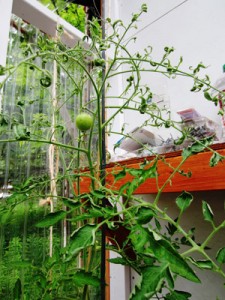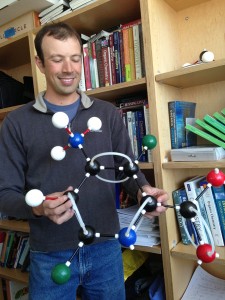The case of the twisted potato plants
by Kathleen McCoy |
A version of this story appeared in the Anchorage Daily News on May 26, 2013.
Ellie Henke is a Talkeetna gardener with a problem in her beds that growers around the state should heed. A weed scientist with the UAF Cooperative Extension Service and a UAA environmental chemist are collaborating to puzzle this one out.
Henke's story goes like this. For four years she enjoyed robust vegetables from soils she'd enhanced with composted manure, lime, blood meal and other typical soil additions. But in 2012, as she wrote to weed scientist Dr. Steven Seefeldt, "Disaster struck."
Last year's growing season began well enough, with healthy sprouts taking off indoors in commercial potting soil "just fine." But when she transplanted her fledgling flowers and vegetables into those outdoor beds, the story changed.

Aminopyralid is an herbicide approved for use in Aaska. However, it may not degrade as quickly in Alaska's cool soils.
Her marigolds didn't flower; instead, they grew odd-shaped leaves and thick stems that looked blistered. After transplanting, her tomatoes got spindly and leaves didn't develop. The same thing happened to her potatoes. Almost none of her peas and bush beans germinated. Carrots and beets grew slow and failed to thrive.
As neighbors do, a frustrated Henke showed her crop to a fellow gardener, who recognized the cupped leaves and fiddle-necked stems as the same nightmare she'd experienced a year earlier. She'd hopped on the Internet, done some research and came up with an hypothesis that Seefeldt says looks about right: contamination from an herbicide used to tamp down weeds in pastures and hay fields.

When tomatoes got started in commercial potting soil, they did fine. But when the gardener moved them into soil she had enhanced with yak manure, their leaves became mishapen. Later she learned the manure may have been tainted by hay from a commercial grower who may have applied aminopyralid to tamp down weeds in the hay field.
The likely culprits, aminopyralid or clopyralid (sold under the brand names of Milestone and Transline), knock out broadleaf weeds like docks and thistles, while hay and grasses grow normally. When the grasses are turned into feed for domestic animals, herbicide residue concentrates in their manure. The manure gets sold or shared with growers, and the aminopyralid ends up in places it was never intended, like Henke's vegetable garden.
Henke and her friend had both used yak manure from a Talkeetna neighbor, who later remembered buying hay from a commercial seller in Point MacKenzie.
Seefeldt had heard this sad tale already. He'd just finished working with a Delta potato farmer who'd sprayed for noxious weeds in an area where he didn't grow any crops. Two years later, he put in potatoes, but reported that his plants grew funny. The potatoes he saved and planted the next year also had problems.
Seefeldt kicked off a study that documented the damage, proving that potatoes are susceptible to aminopyralid. A manuscript is online in June's issue of the American Journal of Potato Research.
The next step is the environmental chemist's job. This summer, Dr. Patrick Tomco will test soils to determine how long the aminopyralid persists in our colder northern soils.
Aminopyralid is approved for use in Alaska by the Department of Environmental Conservation, based on studies done in temperate climates that show a reasonable half-life of 32 days.
"This is a classic example of how extrapolations can result in wonky data," Tomco says. What works in testing soils in California or Florida or Illinois may not duplicate in chilly Alaska.

UAA environmental chemist Pat Tomco assembled a model of aminopyralid as a way to figure out how soil microbes might interact with it.
The way the herbicide has traveled so quickly through Alaska's food chain concerns Seefeldt, Tomco and others, including Bret Burroughs of the Anchorage Soil and Water Conservation District. Despite appropriate package instructions advising users to restrict use and not sell or share manure from animals that have ingested treated grasses, examples are popping up that document aminopyralid in the wrong places.
Right now aminopyralid is expensive, but once it goes off patent, it will be cheap and Tomco worries that use will only spread with lower prices.
Farmers, parks managers and invasive weed specialists all say aminopyralid is very effective against troublesome invaders like orange hawkweed and Canadian thistle. If used correctly, it could support efforts to protect native plant diversity, also an important environmental concern.
Tomco got seed money from UAA to prep some plots in Delta Junction and Palmer that he'll spray this summer with aminopyralid, and then sample the soil to measure the compound's degradation. Sunlight and microbes are thought to degrade the herbicide, so once he knows how fast it is degrading in the field, he'll determine which of the two processes causes the most degradation.
Another big issue is determining how widespread aminopyralid contamination has become. Tomco's goal is to patent a method for determining residue in soil, water or manure. An ideal solution would be a simple dipstick that farmers and citizen scientists can jab into soil and quickly determine the herbicide's level.
His bigger goal is to use data from these early studies to persuade large national funders to finance a look at Alaska's cold climate and how it may inhibit the expected degradation of chemical compounds like aminopyralid.
Palmer-born Tomco returned to Alaska two years ago after earning his doctorate in environmental chemistry from the University of California at Davis. He teaches organic chemistry at UAA and looks for ways to develop research.
In Alaska, it seems he won't have to look far. Already he's talking to the city about testing herbicides on Elodea, an invasive aquarium plant that seems to be taking over Sand Lake. He's growing vats of the stuff in light and temperature controlled glass cases, getting ready to test herbicidal applications in the lab. The concern with Elodea is that floatplanes could easily spread these noxious mats through out Alaska lakes.
And of course, there are those pesky invasive northern pike that threaten to drive much preferred salmon out of our rivers and streams.
"I'll be talking to Fish and Game about rotenone, a piscicide for the pike," Tomco said.
 "The case of the twisted potato plants" is licensed under a Creative Commons Attribution-NonCommercial 4.0 International License.
"The case of the twisted potato plants" is licensed under a Creative Commons Attribution-NonCommercial 4.0 International License.














